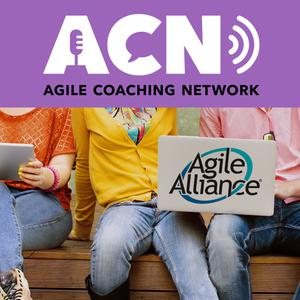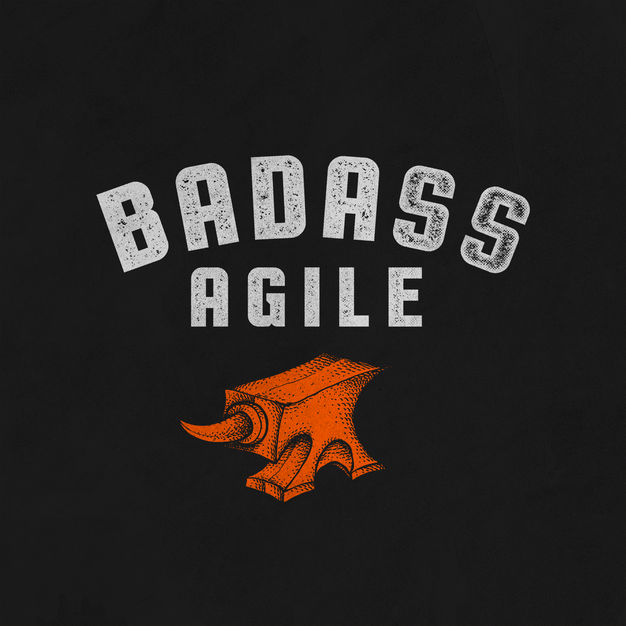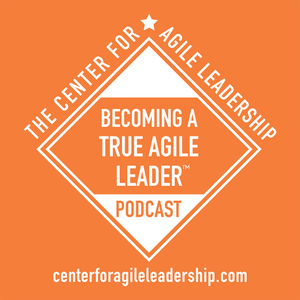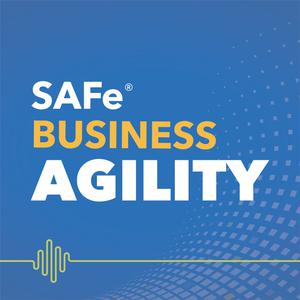
Agile Coaches' Corner
Dan Neumann at AgileThought
- 16 minutes 3 secondsAI: A New Thinking Partner in Agile Teams with Dan Neumann
This week, your host, Dan Neumann, discusses his perspective on the influence of Artificial Intelligence on Agile Teams. AI has created excitement and great expectations, undoubtedly changing how we perceive work and raising some concerns. In this episode, Dan dives deep into how Generative AI can impact Agile Teams’ work, describing AI’s use in this field and using valuable examples to describe several manners to incorporate AI to ease the work at different stages of an Agile process.
Key Takeaways
-
Generative AI, a new thinking partner to Agile Teams:
-
There are sensitivities around using the free AI models currently available.
-
AI could be considered a great partner in addition to Team Members.
-
The definition of done for each project cannot be delegated to AI, since the Team needs to determine the pros and cons, define the goals, and what it means to achieve them.
-
Miro AI can be used as a Retrospective partner to examine the retrospective data the Team has been collecting. It can also help provide different ways of facilitating Retrospectives.
-
-
AI is helpful to Delivery Teams in predicting releases.
-
Agile Teams can use the Monte Carlo Simulation to predict a Team’s velocity by looking at historical data to create a range of future possibilities.
-
-
Sprint planning could be simpler with the aid of AI.
-
An Agile Team can seek AI help to provide other work items that might support the original Sprint Goal, based on the product backlog.
-
-
How can AI assist in dealing with bottlenecks?
-
AI can help identify some bottleneck trends based on the existing delivery data.
-
-
AI as a tool for Product Owners and Quality Specialists to identify Acceptance Criteria:
-
AI can assist Product Owners and Quality Specialists in defying product backlog Item acceptance criteria.
-
To generate new acceptance criteria, test cases can be generated using an AI public tool or a technology ecosystem like Microsoft Copilot.
-
-
Using Microsoft Copilot, a Team can look at the sentiment in which you are engaging with your Teammates.
-
By searching the Team’s chat emails, AI can help you anticipate potential issues.
-
Ai can provide strategies to tackle a potential social challenge that might be reflected in the Team’s communication.
-
-
AI can use your historical information for risk management.
-
AI can help a Team identify risks and develop strategies to solve them or even when to accept those risks since the cost of mitigating them exceeds the Team’s capabilities.
-
-
Agile Teams can use AI for prioritization.
-
AI can explore big data, search for information on costs and benefits, and provide useful suggestions for prioritization.
-
Want to Learn More or Get in Touch?
Visit the website and catch up with all the episodes on AgileThought.com!
Email your thoughts or suggestions to [email protected] or Tweet @AgileThought using #AgileThoughtPodcast!
27 September 2024, 12:00 pm -
- 18 minutes 37 secondsMaximizing Team Autonomy while Maintaining Accountability in Agile Frameworks with Dan Neumann
This week, your host, Dan Neumann, is discussing how to maximize Team autonomy while maintaining accountability within Agile Frameworks. In this episode, Dan defines the importance of autonomy and accountability in Agile. He explains the challenge faced when too much autonomy leads to a lack of accountability while, on the contrary, too much control inhibits innovation and why leaders should prioritize this delicate balance.
Key Takeaways
-
What is Autonomy in Agile?
-
Autonomy is the ability to self-manage, make decisions, and drive solutions.
-
Give Teams the environment and support they need, and trust them to get the job done. Motivated individuals are the key to success!
-
A Manager must welcome changing requirements but needs the Team to maintain focus. Remember, a Team must harness change for the customer’s competitive advantage.
-
Autonomy benefits Agile teams by making decisions faster and fostering creativity and innovation.
-
-
The Role of Accountability in Agile:
-
Accountability in the Agile context means taking ownership of work, meeting commitments, and ensuring transparency.
-
An Agile Coach should account for progress toward the desired outcome. When things go wrong, slow, or burst, the coach should explain why it happened, what measures were in place to help prevent it, and what the team can do to prevent the problem from happening again.
-
Accountability keeps Teams aligned with business outcomes and stakeholders’ expectations.
-
-
Key Strategies for Balancing Autonomy and Accountability:
-
Clearly Defined Outcomes: Focus on the importance of clear goals, shared objectives, and transparency. Teams need freedom to achieve these goals but must stay accountable for delivering them. Tell it, write it, repeat it, and ask others to repeat it.
-
Create a Culture of Trust: Trust between leaders and Teams drives autonomy. Trust the Team to make decisions, and they will take accountability for their outcomes.
-
Use Agile Metrics Thoughtfully: Discuss key metrics like velocity, burn-down charts, and lead time. Always remember that metrics are tools for learning, not for punishment. Emphasize simplicity as the art of maximizing the amount of work not done.
-
Boundary Setting (Guardrails): How Agile coaches and Scrum Masters can establish non-intrusive guardrails (e.g., WIP limits, capacity planning) to ensure teams are free to work without getting lost or overcommitting.
-
-
Leadership’s Role in Supporting Autonomy and Accountability:
-
Some Leadership behaviors that empower teams are removing obstacles, giving space for innovation, innovation week, buffer in a Sprint, spikes, training resources, conferences, and coding retreats (among others).
-
Agile coaches must highlight the need for regular feedback loops, such as retrospectives, to align accountability without micromanaging.
-
Want to Learn More or Get in Touch?
Visit the website and catch up with all the episodes on AgileThought.com!
Email your thoughts or suggestions to [email protected] or Tweet @AgileThought using #AgileThoughtPodcast!
13 September 2024, 2:00 pm -
- 15 minutes 16 secondsTips for Managers to Help Agile Teams with Dan Neumann
This week, Dan Neumann, your host, dives deep into how Managers can support and help their Agile Teams. We often fall into common misconceptions, such as believing that self-managing Teams do not need Functional Managers or finding that the Manager’s role is not well defined, making it difficult to identify how he can assist an Agile Team. In this episode, Dan shares many valuable tips for Managers trying to find the best ways to help an Agile Team.
Key Takeaways
-
Tip No.1: Encourage Team Involvement.
-
Involve the team in the solution process and respect their expertise and opinions.
-
Involving team members in decision-making processes can lead to better
-
alignment, trust, and quality of solutions.
-
Tip No.2: Support Learning and Development.
-
Provide time and resources for training and other activities to support the Team’s learning and development needs.
-
Give Team members time for training and attending relevant events to increase motivation and performance.
-
-
Tip No.3: Foster a Flexible and Adaptive Mindset.
-
Encourage managers to adopt a flexible and adaptive mindset and be open to change and feedback.
-
Being adaptable and responsive to changes in the Agile environment has remarkable benefits.
-
-
Tip No.4: Measure and Improve Workflow.
-
Identify wasteful activities like handoffs and delays and streamline the flow of value to customers.
-
Measuring the total time to deliver customer value and designing an effective workflow can improve Team efficiency.
-
-
Tip No.5: Align Teams with Common Visions and Goals.
-
Form networks of teams centered on common customers and products and push decision-making out to the network's edges.
-
A Manager should align teams with a shared vision and goals rather than top-down control.
-
-
Tip No.6: Celebrate Successes and Learn from Challenges.
-
Celebrate the team's successes and identify root causes for defects or challenges to improve continuously.
-
Celebrating achievements and learning from challenges fosters a positive Team culture.
-
Want to Learn More or Get in Touch?
Visit the website and catch up with all the episodes on AgileThought.com!
Email your thoughts or suggestions to [email protected] or Tweet @AgileThought using #AgileThoughtPodcast!
6 September 2024, 12:00 pm -
- 33 minutes 52 secondsProject Inception Activities: Setting the Stage for Success with Mike Guiler
This week, Dan Neumann welcomes Mike Guiler to explore starting on the right foot and staying aligned during the delivery process. In this episode, Dan discusses the crucial activities that set the stage for a successful project inception. Whether starting a new project or re-initiating an existing one, these activities are essential for aligning your Team, stakeholders, and vision.
Key Takeaways
-
Understanding Project Inception:
-
Project inception is the initial phase of a project where we lay the groundwork for everything that follows. It’s about understanding the project’s goals, scope, and constraints.
-
This phase is critical because it helps ensure that everyone involved clearly understands what the project aims to achieve and how we plan to get there.
-
-
Key Activities in Project Inception:
-
Vision and Goals Workshop:
-
Gather key stakeholders to define the project’s vision and goals.
-
Discuss the desired outcomes and how they align with the organization’s strategic objectives.
-
Create a shared understanding of the project’s purpose and success criteria.
-
Stakeholder Identification and Analysis:
-
Identify all stakeholders on whom the project will impact.
-
Analyze their interests, expectations, and potential influence on the project.
-
Develop a stakeholder engagement plan to ensure effective communication and collaboration.
-
Scope Definition:
-
Clearly define the project’s scope, including what is in and out of scope.
-
Use techniques like user stories, use cases, and process flows to capture requirements.
-
Prioritize requirements based on business value and feasibility.
-
Risk Assessment:
-
Identify potential risks that could impact the project’s success.
-
Assess the likelihood and impact of each risk.
-
Develop mitigation strategies to address high-priority risks.
-
Team Formation and Roles:
-
Assemble the project Team and define roles and responsibilities.
-
Ensure that Team members have the necessary skills and expertise.
-
Foster a collaborative and supportive Team environment.
-
Initial Planning and Roadmap:
-
Develop a high-level project plan and roadmap.
-
Identify key milestones and deliverables.
-
Establish a timeline for the project’s major phases and activities.
-
Best Practices and Tips:
-
Engage Stakeholders Early and Often:
-
Regularly communicate with stakeholders to keep them informed and engaged.
-
Use feedback loops to ensure that their needs and concerns are addressed.
-
-
Be Flexible and Adaptable:
-
Be prepared to adjust the project plan as new information emerges.
-
Embrace change and use it as an opportunity to improve the project.
-
-
Focus on Value Delivery:
-
Prioritize activities and deliverables that provide the most value to the organization.
-
Continuously evaluate and adjust the project’s direction to maximize value.
-
-
Mentioned in this Episode:
Want to Learn More or Get in Touch?
Visit the website and catch up with all the episodes on AgileThought.com!
Email your thoughts or suggestions to [email protected] or Tweet @AgileThought using #AgileThoughtPodcast!
23 August 2024, 12:00 pm -
- 40 minutesExcellence Exhaustion: What Is It and How to Prevent It, with Nina Sossamon-Poghe
This week, Dan Neumann welcomes Nina Sossamon-Poghe to today’s conversation. Nina has an interesting background as a U.S. gymnast, a News Anchor, and a Corporate Leader with a unique perspective on resilience, mental health, and well-being.
In this episode, Dan and Nina discuss an innovative concept, Excellence Exhaustion, while they define and analyze its significance. Nina also shares the “Resilience Route Navigator,” a framework designed to help high achievers combat Excellence Exhaustion.
Key Takeaways
-
What is Excellence Exhaustion?
-
Excellent Exhaustion is different from burnout. Nina likes to define burnout as the mental exhaustion resulting from doing the same thing repeatedly.
-
Excellence exhaustion is the stress and anxiety experienced by high achievers who are driven to surpass their previous achievements.
-
Constantly advancing technology and perpetual connectivity are drivers of Excellence Exhaustion.
-
The Symptoms of Excellence Exhaustion are anxiety, mental fatigue, reduced motivation, and diminished productivity.
-
-
The Resilience Route Navigator:
-
The Resilience Route Navigator is a framework that helps high achievers combat Excellence Exhaustion through TIPS: Timeline, Isolate the Problem, People, and Story.
-
Timeline thinking: This step is needed to acquire perspective. Whatever is happening to you, put it in the timeline of your life; check on the life that came before this moment and all the blank space ahead for the years yet to come. This exercise is also a great way to gain appreciation for all you have done in your journey so far.
-
Isolate the Problem: Focus on your current situation and leave the past and the future out. At this stage, the present is the main event; this is the only area in which you can take action.
-
People: Who is in this struggle with you? You are not alone. Seek the assistance of others who can assist you in navigating the current situation.
-
Story: It is crucial that you choose the words you use to tell the story of what is going on in your life. Narrate the events in the most empowering and optimistic manner.
-
Mentioned in this Episode:
Want to Learn More or Get in Touch?
Visit the website and catch up with all the episodes on AgileThought.com!
Email your thoughts or suggestions to [email protected] or Tweet @AgileThought using #AgileThoughtPodcast!
9 August 2024, 12:00 pm -
- 23 minutes 44 secondsKanban Essentials: How and When to Start with Mike Guiler
This week, your host, Dan Neumann, welcomes Mike Guiler to discuss a recent course on Kanban Essentials they experienced together. By the end of the classes, they encountered a common feeling in some participants: fear of failing. Often, acquiring new knowledge, embarking on a new journey, or using a new tool can trigger insecurities: What could happen if it is not right? Where do I begin?
In this episode, they encourage Agilists to face this first stage of hesitation, analyze the limitations, and consider the best scenarios for using a new tool or enforcing an innovative strategy through implementing Kanban.
Key Takeaways
-
Kanban Essentials:
-
Agilists might hesitate to incorporate Kanban into their projects for the first time. It is common to feel insecure and doubt whether it is implemented correctly and how effective it would be.
-
The whole Team has to take ownership of trying Kanban to solve an existing problem.
-
-
How to start using Kanban?
-
Start Kanban with matters you can control.
-
Make sure you identify the expected result from implementing Kanban and have a way to measure its effectiveness.
-
First, start using Kanban to solve a small problem. After solving it successfully, the Team will earn much more credibility and encouragement to use it to solve a more complicated issue.
-
You can start using your personal Kanban board and convince the entire Team to use it for the whole system.
-
-
The Problem of Local Optimization:
-
Sometimes, a Team optimizes its work, but this does not translate to the entire organization, resulting in one Team working more effectively when the rest isn’t on the same page.
-
There is a need to start small and locally but have the bigger system in mind.
-
-
Make your work visible.
-
It is crucial to agree on the definition of used terminology (for example, what does a Team define as “done”?).
-
A Team must stop and think about how they are doing what they are doing, and ways to improve it.
-
Mentioned in this Episode:
Want to Learn More or Get in Touch?
Visit the website and catch up with all the episodes on AgileThought.com!
Email your thoughts or suggestions to [email protected] or Tweet @AgileThought using #AgileThoughtPodcast!
2 August 2024, 12:30 pm -
- 37 minutes 13 secondsA Journey into Project Retrospectives with Norm Kerth
This week, your host, Dan Neumann, is joined by Norm Kerth, author of Project Retrospectives: A Handbook for Team Reviews. Norm Kerth wrote this book before Sprint Retrospectives were invented! In this episode, Norm and Dan explore the subject of Project Retrospectives. They discuss the learning opportunity within every major project event, especially in instances where things did not turn out favorably. Norm explains when and when not to have a Retrospective and how to prove its value to organizations reluctant to grant the necessary time to invest in them.
Key Takeaways
-
An unconventional career:
-
Norm realized that the best way to move up inside a corporation was not to be in line or follow other people’s paths but to find the void that other people were leaving in the company and fill it. This is an amazing way to contribute.
-
Norm wrote the book Project Retrospectives even before retrospectives and sprints were created.
-
-
Project Retrospective:
-
Learning from past experiences is quite valuable, which is why Retrospectives are so beneficial for a Team.
-
The first step is to assume that every member of the Team is doing the best they can according to their capacities and knowledge. If this is not the foundation, people will fear being blamed for mistakes or errors instead of focusing on the learning opportunity.
-
Once the Team has learned from past experiences, they can decide how they will operate differently in future circumstances.
-
Retelling the story is very crucial.
-
The necessary four questions: What went well? What did I learn? What do I want to do differently the next time? What still puzzles me?
-
-
Retrospectives need time, but organizations do not always agree.
-
When you reach the end of a project and are late starting the new one, don’t rush! Remember that if there is no reflection on the last project, the following will repeat its mistakes.
-
The best way to improve organizational processes is to involve the people doing the work.
-
Consultants must ask four questions: How did you get to where you are? How do you feel about where you are at the moment? Where do you want to go? What do you want to do differently? The Retrospective is the way to find the answers to these questions.
-
-
When is a Retrospective not needed?
-
There is no point in having a retrospective in dysfunctional organizations. It doesn’t matter how a Team changes its ways if the organization has major conflicts that are not addressed.
-
The manager needs to be involved in Retrospectives; if there is no collaboration from leadership, why waste the time?
-
Don’t do the Retrospective only because it is trendy to do it.
-
-
How can Retrospective’s value be demonstrated?
-
First, retell the story of the project, going through the most significant events. Search for the wisdom while answering the four questions.
-
Break the Team into naturally affinity groups (they will probably group together according to the area of work). These subgroups are encouraged to propose what they want to do differently. These suggestions have to be achievable and measurable so their value can be tested in the following Retrospective.
-
Mentioned in this Episode:
Project Retrospectives: A Handbook for Team Reviews, by Norm Kerth
Want to Learn More or Get in Touch?
Visit the website and catch up with all the episodes on AgileThought.com!
Email your thoughts or suggestions to [email protected] or Tweet @AgileThought using #AgileThoughtPodcast!
26 July 2024, 12:00 pm -
- 39 minutes 36 secondsLiberating Structures with Kristen Belcher
This week, your host, Dan Neumann, is joined by an external guest: Kristen Belcher, a Software Developer turned Agile Coach. In this episode, they discuss liberating structures, simple and subtle tools that can help everyone attending a group event contribute and be included. They dive deep into some of the Liberating Structures, such as 1-2-4-All, Drawing Together, Purpose-to-Practice, and TRIZ. Listen to this thoughtful conversation and get ready to apply some of these practices to the next event you facilitate.
Key Takeaways
-
Many structures we use with groups, like presentations, status reports, and even tight discussions, tend to fail because they don’t have space for all the participants’ voices or allow members to think “outside the box.” Sometimes, there is even no structure at all. Liberating structures are the tools that liberate everyone in the conversation to contribute and be included.
-
We all have different participation styles: thinkers, talkers, and quiet ones. We all communicate in unique manners, and our input is equally valuable.
-
There are 33 liberating structures.
-
One Liberating Structure is 1-2-4-All. You can apply it starting with 1: People have time to think on their own. Then 2: They pair up and discuss with another person. Then 4: The pairs will pair, generating themes and sharing what they learn. Finally, All: Where everybody can share their ideas. Even though everyone won’t be allowed to speak to the large group, they had the chance to contribute in the previous instances.
-
Another Liberating Structure is called Drawing Together. Everyone needs to draw a picture using the same shapes (no artistic ability is required). Every shape has a significance: Circles stand for wholeness, rectangles represent support, triangles represent goals, spirals represent changes, and the stick or star persons represent relationships. The group interprets a picture, and these views are the kickstart for a discussion.
-
Purpose-to-Practice is a tool for identifying our main purpose and rooting the members together. It helps realize who must be included to achieve a shared purpose.
-
TRIZ is the liberating structure created to assess the absolute worst scenario that can happen.
-
-
When choosing a liberating structure, you must match it with the problem you are trying to solve in a group.
-
First, you need to frame the problem to find the right tool to approach it.
-
It's a good idea to have a Plan A and a Plan B for facilitation.
-
-
How can you start applying Liberating Structures?
-
When approaching liberating structures, you will first learn what they are for, then how to approach the space, how people participate, groups, and the sequence of steps to be followed. The material also provides time allocations. You will receive minimum specifications of how the liberating structures are set up.
-
There is no specific script about how you should facilitate.
-
Be comfortable doing something uncomfortable and new.
-
Mentioned in this Episode:
Download the Liberating Structures App
The Art of Gathering, by Priya Parker
The Fearless Organization: Creating Psychological Safety in the Workplace for Learning, Innovation, and Growth, by Amy C. Edmondson
Right Kind of Wrong: The Science of Failing Well. by Amy C. Edmondson
Want to Learn More or Get in Touch?
Visit the website and catch up with all the episodes on AgileThought.com!
Email your thoughts or suggestions to [email protected] or Tweet @AgileThought using #AgileThoughtPodcast!
19 July 2024, 12:00 pm -
- 37 minutes 41 secondsSeven Tips for Agile Facilitation with Dan Neumann and Justin Thatil
This week, your hosts, Dan Neumann and Justin Thatil, share seven tips for Agile Facilitation. Collaboration is necessary when solving a problem, and Agile Coaches and Masters work to enable a Team to cooperate. Every event is unique, which is why Facilitation could be considered a form of art.
Key Takeaways
-
Contextual Awareness:
-
Teams and events are filled with unique variables that the facilitator cannot always anticipate; as a result, reading the overall atmosphere of a room and the individuals’ body language is a fundamental skill for Facilitators.
-
Every Facilitator has to remember that they are facilitating for a specific audience. Who is this meeting for? What is the value for these participants?
-
-
Use Time boxes.
-
A Facilitator must master the flow of the meeting to achieve the goal in a timely manner.
-
A Facilitator should design the session with the intended activities, promote collaboration from collaborators, and be flexible enough to adapt to changes.
-
-
Mastering the act of active listening:
-
Listening is achieved when being fully present.
-
Seek to understand.
-
Facilitators must be able to paraphrase what they just listened to to ensure they understand what the collaborator is saying.
-
Are collaborators listening to each other? A Facilitator must also promote active listening among participants.
-
-
A Facilitator must foster an open and inclusive communication environment.
-
A Facilitator must become a master observer of the room. Who is participating? Who is silent?
-
-
Design a power start!
-
Set the purpose and the intended outcome for the meeting. This will improve participant engagement.
-
Specify how participants can engage.
-
Visual Facilitation tools are incredibly beneficial for a better Facilitation.
-
-
A Facilitator must handle conflict with grace.
-
Conflict is inevitable, especially in a collaborative environment.
-
Participants should be encouraged to learn from each other. Conflicting perspectives must both be validated.
-
A Facilitator must be clear about which behaviors are acceptable. Safe boundaries are essential to hosting a psychologically safe environment.
-
-
Facilitators must continuously improve their skills.
-
Facilitators must apply learnings in a setting first to realize how they can be improved.
-
Pairing with other Facilitators can be a great way to keep learning continuously.
-
Mentioned in this Episode:
Empowered: Ordinary People, Extraordinary Products (Silicon Valley Product Group), by Marty Cagan and Chris Jones
Want to Learn More or Get in Touch?
Visit the website and catch up with all the episodes on AgileThought.com!
Email your thoughts or suggestions to [email protected] or Tweet @AgileThought using #AgileThoughtPodcast!
12 July 2024, 12:00 pm -
- 37 minutes 31 secondsMain Challenges of Product Practice with Ned Pope
This week, your host, Justin Thatil, welcomes Ned Pope, Director of Product Practice at Agile Thought. In this episode, Ned and Justin explore the most common challenges encountered while engaging with an enterprise client. Ned shares valuable insights regarding creating a new product effectively and timely, emphasizing the crucial value of openness and collaboration within a Team. Ned highlights the importance of focusing on the problem, the elements of the solution, and how they can be broken down to prioritize the most unique and highest value for clients and customers.
Key Takeaways
-
Enterprise clients are dealing with a massive sector of the marketplace.
-
There is a wide range of variance in what the clients are trying to accomplish, so it is important to ground them in their thinking around problem-solving. If you can remove even a minor inconvenience from someone's day, you add value to their life.
-
There must be a list of priorities from executive and senior leadership within the enterprise clients, along with the dates they will be needed. This road map is not based on capacity or capability to deliver a solution around a specific item to be delivered at a particular time.
-
Don’t get frustrated when trying to create a digital product. There is a reason this solution doesn’t exist yet, or in the form you are trying to build it.
-
Make sure everyone is aligned and on the same page.
-
-
Understand and respect the current processes within an Organization.
-
The organization has already figured out how to solve the problem in the current fashion, and you do not want to disrupt that but to provide something that makes that process more manageable, enhances that solution, and makes it more effective and scalable.
-
-
There are tangible elements that form a culture.
-
Empower teams to think creatively about a solution.
-
Openness, resourcefulness, and collaboration are critical elements of an Agile Team.
-
-
Move UX design and UI library components as visual references at the beginning of the process to save time and ultimately allow for a better product.
-
We often get to the details and the complexity of the work and then begin to get consumed with all the nuance and intricacy of the daily work, which can lead to overseeing the most basic aspects.
-
Remember, you are building a visual tool!
-
The vast majority of technology has some form of interface, which generates success and speed with quality and accuracy.
-
Provide visual references to align the Team with what you are trying to accomplish and execute. It is recommended that you bring in a highly skilled UX Designer to the heart of the Product Discovery. Don’t wait until the process is in development; the UX designer needs to join the process from the beginning.
-
Use a UI library.
-
Mentioned in this Episode:
Want to Learn More or Get in Touch?
Visit the website and catch up with all the episodes on AgileThought.com!
Email your thoughts or suggestions to [email protected] or Tweet @AgileThought using #AgileThoughtPodcast!
28 June 2024, 12:00 pm -
- 30 minutes 50 secondsComplementary Practices in Scrum with Mike Guiler
This week, your host, Justin Thatil, is joined by Mike Guiler to explore complementary practices in Scrum. The Scrum Guide intentionally left many open questions for users to adapt and practice flexibility.
In this episode, Justin and Mike outline several practices, such as identifying the product vision, adapting the Kanban Board, and providing visual information regarding the production process. They also discuss the benefits of using Kanban’s lead and cycle time metrics and close this conversation by diving deep into the importance of identifying a shared definition of ready.
Key Takeaways
-
Product Vision:
-
Scrum is always about outcomes.
-
How do we find the right outcome to deliver to our customers?
-
First, we need to be clear about the product vision and what the organization considers a priority.
-
Second, the Team comes up with a plan to achieve that vision, which unlocks an organization's power.
-
-
-
Adapt a Kanban board.
-
The Kanban board helps to visualize the process at a particular sprint timebox.
-
Many benefits result from visualizing the steps in the Kanban Board.
-
-
Scrum with Kanban:
-
Stop starting and start finishing! Look at what you are doing and implement better Teamwork.
-
Kanban’s lead time and cycle time metrics give an indication of the system's progress and whether it is getting better. The cycle time measures the time it takes an idea since it enters a print backlog until it is delivered to the customer, while the lead time gives more of a system view.
-
-
Find your definition of “ready.”
-
What has to happen to make a product backlog ready?
-
Get to a shared understanding of what is considered ready within a Team.
-
Reduce the ambiguity about what should and shouldn’t be in the product backlog, resulting in a better sprint plan.
-
Mentioned in this Episode:
Listen to Episodes 277 and 279 of The Agile Coaches Corner.
Sprint: How to Solve Big Problems and Set New Ideas in Just Five Days, by Jake Knapp
Want to Learn More or Get in Touch?
Visit the website and catch up with all the episodes on AgileThought.com!
Email your thoughts or suggestions to [email protected] or Tweet @AgileThought using #AgileThoughtPodcast!
21 June 2024, 12:00 pm -
- More Episodes? Get the App
Your feedback is valuable to us. Should you encounter any bugs, glitches, lack of functionality or other problems, please email us on [email protected] or join Moon.FM Telegram Group where you can talk directly to the dev team who are happy to answer any queries.
 Agile Coaching Network
Agile Coaching Network
 Badass Agile
Badass Agile
 Becoming A True Agile Leader(tm)
Becoming A True Agile Leader(tm)
 SAFe Business Agility Podcast
SAFe Business Agility Podcast
 Women in Agile
Women in Agile
 LeadingAgile SoundNotes: an Agile Podcast
LeadingAgile SoundNotes: an Agile Podcast